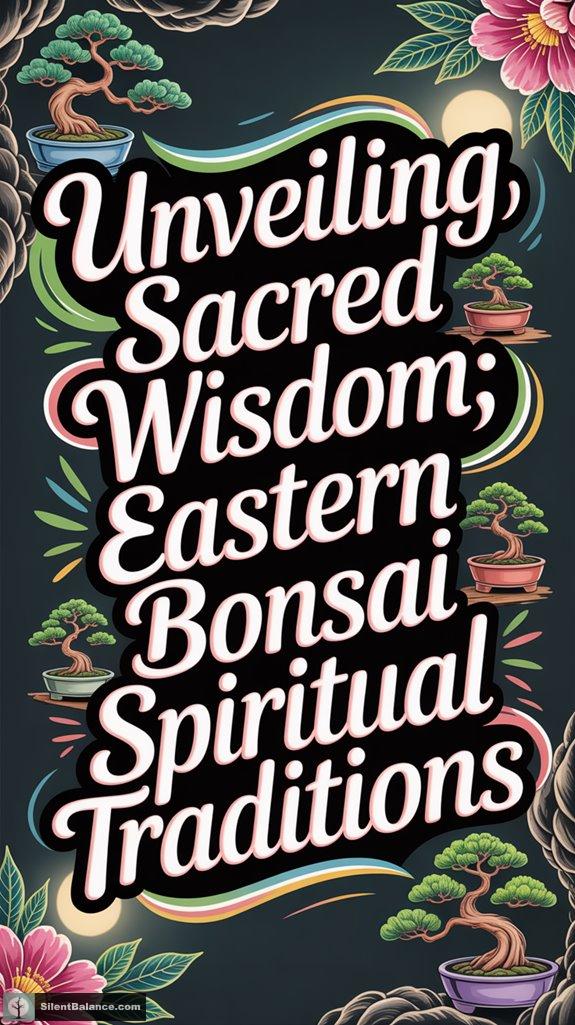Bonsai isn’t just about cute mini trees; it’s a gateway into Eastern spirituality! Originating from China’s penjing, this art form channels Zen Buddhism’s mindfulness and Daoist harmony with nature. Each twisty branch and gnarled root tells its own story, reflecting simplicity and imperfection through wabi-sabi aesthetics. And let’s be honest, who doesn’t love a bit of charming character in their creations? So, buckle up as we journey deeper into the leafy wisdom of bonsai traditions!
Quick Takeaways
- Bonsai emerged from Chinese penjing, embodying luxury and mystical significance in spiritual traditions, reflecting an elite connection to nature.
- Zen Buddhism infuses bonsai cultivation with mindfulness, promoting inner peace through patient and intentional tree shaping as a meditative practice.
- Daoist principles, such as wu wei, highlight harmonious engagement with nature, emphasizing balance and effortless action in bonsai artistry.
- The aesthetics of wabi-sabi celebrate imperfection, illustrating the beauty of nature’s flaws and the passage of time, enriching the spiritual experience.
- Global interest in bonsai fosters cultural exchange, blending traditional Eastern philosophies with diverse interpretations, enhancing spiritual connection across various communities.
Origins of Bonsai: From Penjing to Japan
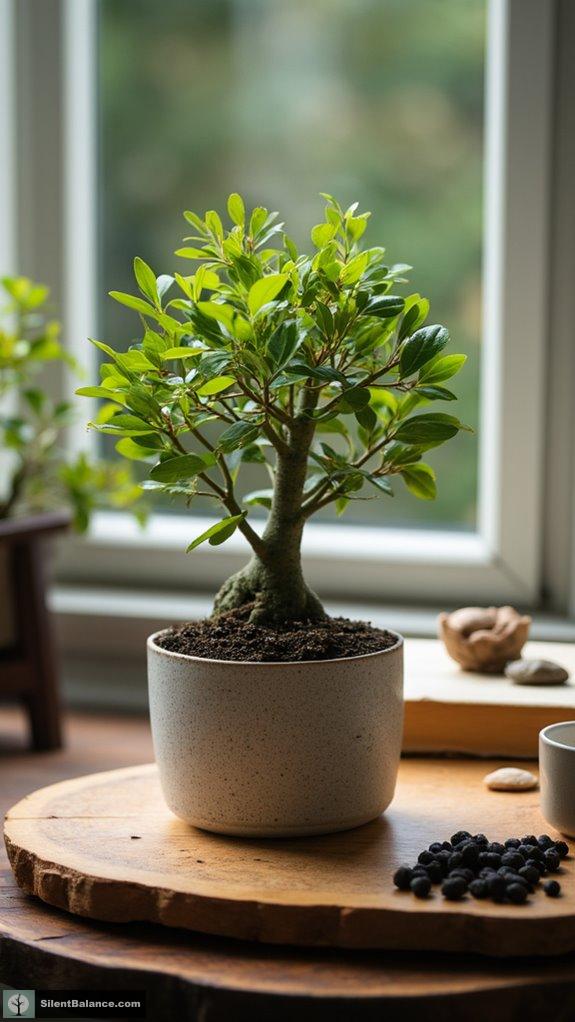
When you think about bonsai, did you know its roots dig deep into Chinese culture through a fascinating practice known as penjing? This noble art dates back to at least 600 AD, with whispers suggesting even earlier origins.
Picture the elites cultivating miniature wonders, showcasing their power with these luxurious gifts. Isn’t that delightful?
As they say, “Size doesn’t matter.” Those mini environments carried immense significance, blending beauty with mysticism. Miniature trees and shrubs were believed to have mystical powers, enhancing their value in Chinese gardens.
When Buddhist monks later introduced penjing to Japan, bonsai blossomed, transforming its own unique style. The nuances between these practices are enticing, don’t you agree?
Immerse yourself in the world and embrace the elegance!
Influence of Zen Buddhism on Bonsai Practices
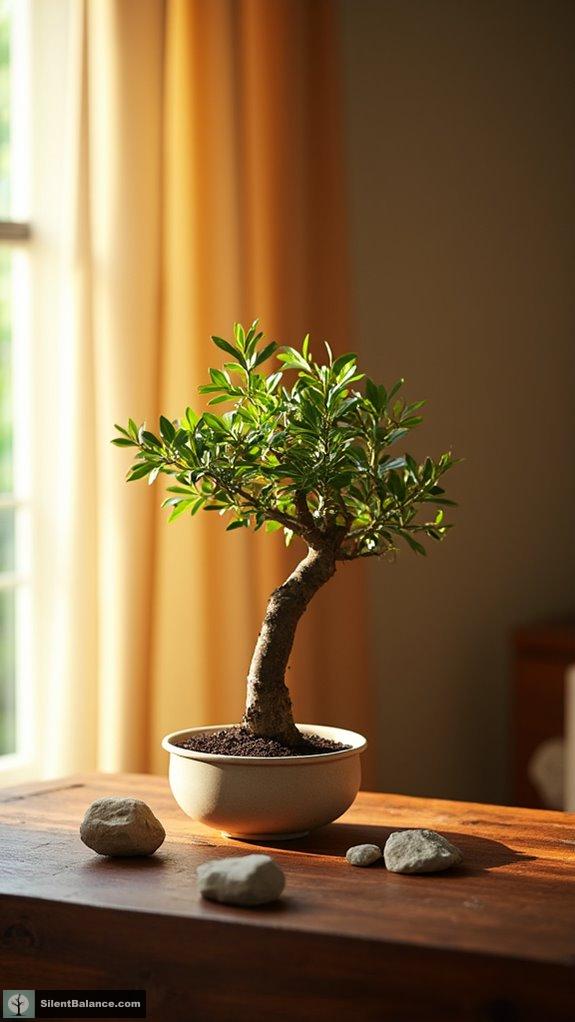
As I immerse myself in the fascinating world of bonsai, it’s hard not to feel the subtle spiritual energy that courses through each miniature scene, rooted firmly in the teachings of Zen Buddhism.
The essence of bonsai encapsulates mindfulness, patience, and an embrace of life’s impermanence. Ever pruned a tree and felt its lessons of acceptance?
Bonsai teaches us acceptance through mindfulness and patience, mirroring life’s transient beauty.
The beauty of wabi-sabi, with its charming irregularities and unpretentious simplicity, truly captures Zen aesthetics. It’s moving meditation.
As I shape my bonsai, I connect deeply with nature, transcending the mundane.
Are you ready to cultivate your inner peace through this powerful art? Let’s grow together.
Daoist Philosophical Reflections in Bonsai Art
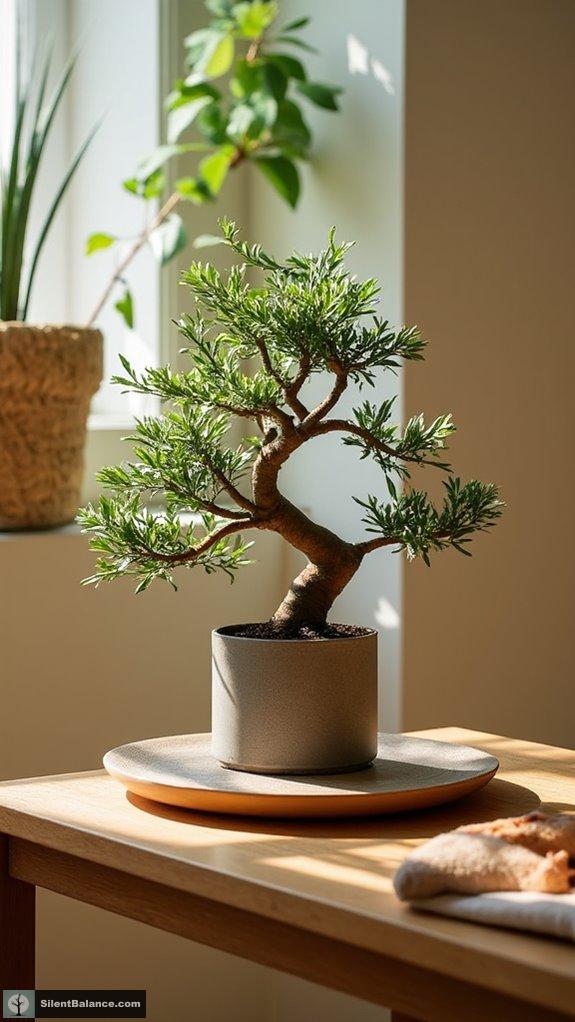
Diving into the domain of bonsai art, I quickly realize it’s not just about pruning and shaping; it’s a beautiful embrace of Daoist philosophy that weaves itself into every branch and leaf.
The Dao, the very “way,” calls us to align effortlessly with nature’s rhythms—think wu wei in action.
Symbolism of Trees in Eastern Spiritual Traditions
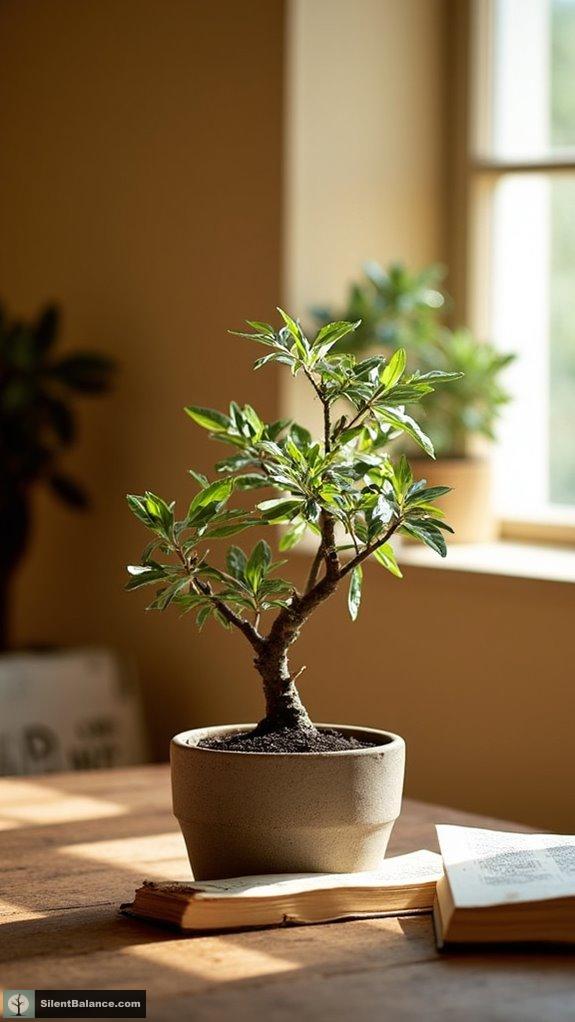
Trees hold a special place in Eastern spiritual traditions, serving as profound symbols that connect the earthly with the celestial.
Ever thought about how the mighty banyan tree embodies eternal life, wisdom, and cosmic cycles? It’s like a living library of knowledge! The Bodhi tree, where the Buddha found enlightenment, speaks volumes about liberation.
These trees remind us that life’s intertwined—our roots in the earth, branches reaching for the heavens.
In bonsai, each twist and turn of a tree tells a story of resilience, right?
Aesthetics of Wabi-Sabi in Bonsai Design
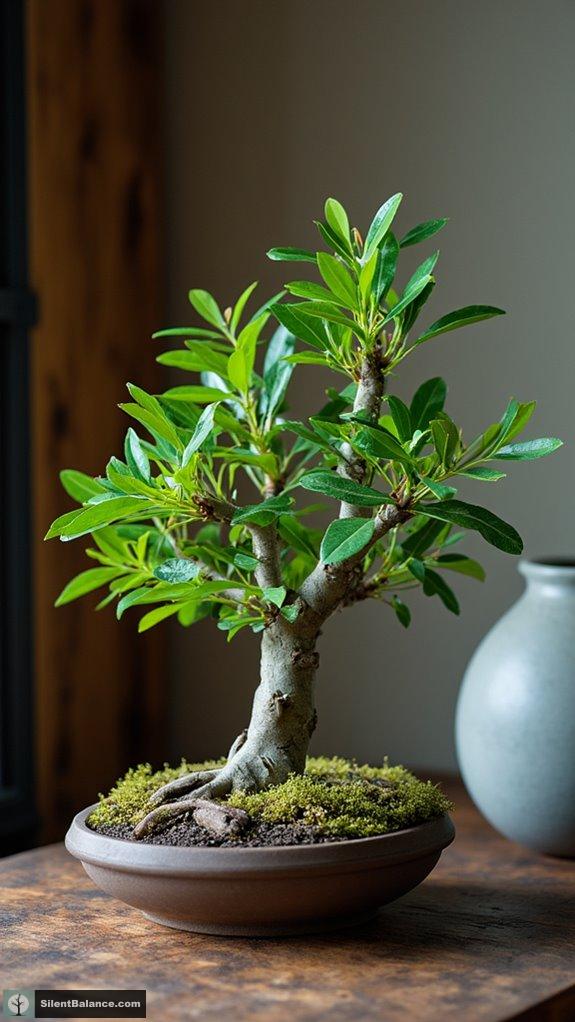
Bonsai isn’t just about trimming branches and arranging little trees; it’s a vibrant blend of aesthetics, philosophy, and artistry that celebrates the beauty of imperfection.
Wabi-sabi drives this design, embracing asymmetry while highlighting simplicity and uncontrived forms.
Don’t you love the charm of natural roughness, showing time’s graceful touch?
It’s about an essence that whispers serenity and evokes contemplation.
Every broken branch tells a story, right?
With intentional minimalism and space, bonsai becomes a focal point in its surroundings—an intimate dance of nature and art.
Cultural Significance of Bonsai in Japanese Society

Envision wandering through a serene Japanese garden, where the artistry of nature gracefully unfolds in miniature.
Bonsai isn’t just a hobby; it’s a pulse within Japanese culture. From those ancient Zen monasteries, these miniature marvels transformed into status symbols, a reflection of exclusivity and refinement.
Recall those elite gatherings? Bonsai trees graced tokonoma as silent sentinels, whispering tales of patience, dignity, and honor.
Isn’t it fascinating how nurturing a tree reflects our own journey?
Shouldn’t we embrace that lifelong commitment? Every twist and turn of a bonsai mirrors our complexities, connecting us profoundly to nature, tradition, and ourselves.
Horticultural Techniques and Spiritual Connection

When you explore the artistry of bonsai, you quickly realize it’s not just about the trees; it’s a dance of technique and spirituality intertwined.
Pruning embraces patience, while wiring dances between creativity and discipline. Ever tried the “clip and grow” method? It’s like orchestrating a majestic performance where each snip enlivens your tree.
Soil’s role? Essential—imagine your bonsai thriving in a concoction of organic matter, clay, and gravel, each particle a breath of life.
Do you feel that connection? The act of nurturing transforms into a meditative ritual, reflecting life’s ephemerality and our dynamic bond with nature’s essence.
Isn’t that powerful?
Global Impact and Modern Interpretations of Bonsai Spirituality

While diving into the world of bonsai, you might just stumble upon an intriguing blend of old traditions and modern twists that make this art form even more enthralling.
Bonsai’s global journey kicked off in the 1970s, morphing from a Japanese craft into a worldwide sensation. Think about it—over 100,000 enthusiasts across more than 100 countries!
This isn’t just about aesthetics; it’s spiritual, blending Zen principles with local flair. Have you felt that meditative calm from a tiny tree?
Each exhibition showcases diverse artistic interpretations, reflecting how bonsai transcends borders, proving it’s not just gardening, but a powerful cultural exchange thriving in our world today.
Rooted in Harmony

Bonsai cultivation isn’t merely a journey of aesthetics; it’s a dance with nature, where every snip of shears and curve of branches resonates with harmony.
When I nurture my bonsai, I find an electric connection, balancing soil, moisture, and sunlight like a maestro conducting a symphony.
Isn’t it thrilling to witness nature’s personality unfold in a pot? Each tree tells a story, reflecting virtues and auspicious signs, inviting us to embrace creativity and patience.
In this sacred practice, I learn resilience, merging my spirit with every twist and turn—creating not just art, but harmony with the universe itself. As I cultivate these miniature trees, I am reminded of the profound zen symbolism that permeates this ancient art form.
Questions and Answers
What Are the Best Tree Species for Bonsai Beginners?
If you think you need a PhD to start with bonsai, think again!
Some of the best beginner species include the resilient Ficus and adaptable Chinese Elm.
They’re like the gym buddies of the bonsai world—always there and forgiving when life gets busy.
With easy pruning and low maintenance, you’ll feel like a master gardener in no time.
So, grab your pruning shears and release your inner bonsai artist!
Ready to grow?
How Long Does It Take to Grow a Bonsai Tree?
Growing a bonsai tree can be a rewarding journey, taking anywhere from 5 to 10 years before it really starts showing off its artistic flair.
When you start from seed or a sapling, patience is key, my friend! You can snag a pre-grown beauty, though, which cuts that waiting time considerably.
Remember, bonsai’s an art form, so every twist and turn requires your dedication.
Ready to dig in? Your masterpiece awaits!
Can Bonsai Be Grown Indoors Successfully?
Absolutely, you can grow bonsai indoors, but it’s like nurturing a mini masterpiece!
To thrive, they need loads of light, so think south-facing windows—it’s their sunny spa day!
Humidity plays a hero’s role too, so misting is essential.
And don’t forget, regular pruning keeps them in shape, like a bonsai personal trainer!
With the right species and attention, your indoor bonsai can flourish, transforming your space into a green oasis.
Ready to give it a try?
What Tools Are Essential for Bonsai Cultivation?
When diving into bonsai cultivation, you’ve gotta have the right tools in your arsenal!
First off, sharp shears and concave cutters are a must for clean cuts. Don’t skimp on bonsai scissors for detailed pruning, either.
Plus, root prune shears and hooks are essential for repotting.
Think of wire bending pliers as your magic wand for styling.
How Can I Find a Bonsai Community Near Me?
Finding a bonsai community near you is like searching for gold amid scattered pebbles; it requires a little digging.
Start by checking out BonsaiEmpire.com for local clubs, or swipe through social media to connect with fellow enthusiasts.
You could also swing by botanical gardens—they often host workshops and events.
Isn’t it exciting to learn the art of wiring and pruning while surrounded by others who share your passion? Grab your tree and join the fun!
References
- https://www.ultra-unlimited.com/blog/the-ancient-art-of-bonsai-a-bridge-between-spirituality-ecology-and-global-appreciation
- https://www.bonsaiempire.com/origin/bonsai-history
- https://en.wikipedia.org/wiki/History_of_bonsai
- https://berkleycenter.georgetown.edu/posts/japanese-religious-tradition-and-culture-the-toro-bonsai-village/
- https://www.pabonsai.org/bonsaifacts
- https://www.wbffbonsai.org/bonsaihistory
- https://www.bonsai-nbf.org/blog-archive/2019/10/7/penjing-master-weighs-in-what-are-the-differences-between-bonsai-and-penjing
- https://en.wikipedia.org/wiki/Penjing
- https://deeperjapan.com/the-history-of-bonsai
- https://www.yorkshirebonsai.co.uk/blogs/news/the-origins-of-bonsai-a-journey-through-time-and-culture
- Bonsai Placement Benefits for Room Harmony - November 8, 2025
- Why Use Air Layering to Propagate Bonsai Trees? - November 8, 2025
- 15 Stunning Acorn Wood Wall Art Ideas - November 8, 2025

